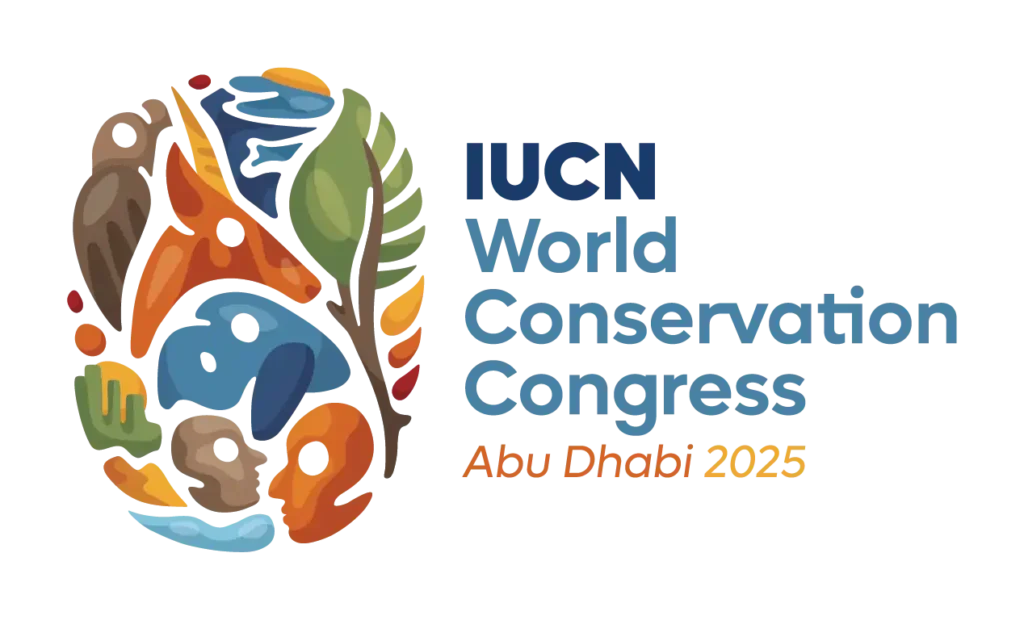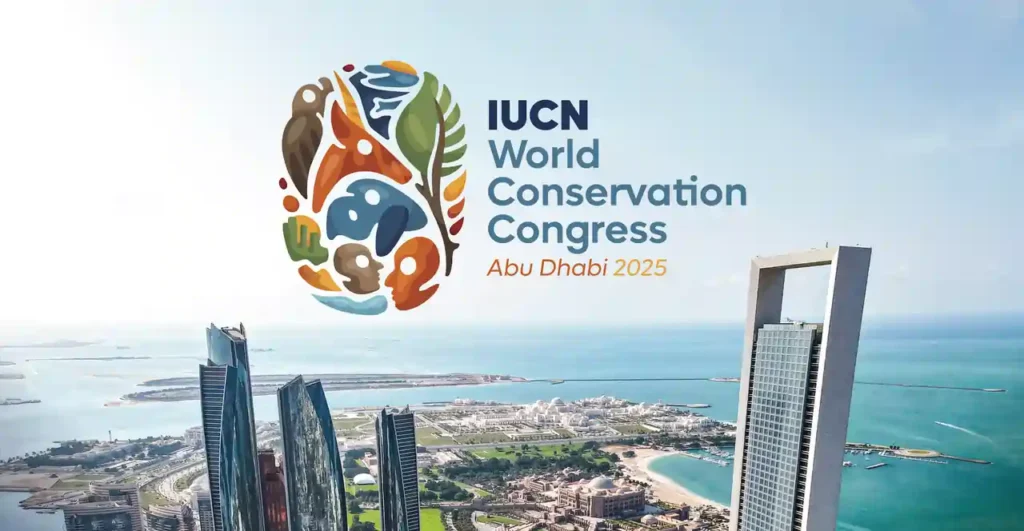New Delhi: The 2025 edition of the International Union for Conservation of Nature (IUCN) World Conservation Congress has wrapped up in Abu Dhabi, United Arab Emirates, after an intensive week of discussions and decision-making. This event, occurring every four years, serves as a critical platform for shaping worldwide environmental policies. At its core is the Members’ Assembly, recognized as the IUCN’s paramount decision-making entity, where representatives from diverse sectors convene to address urgent conservation challenges.

IUCN World Conservation Congress 2025 in Abu Dhabi
The official logo of the IUCN World Conservation Congress 2025, symbolizing unity in nature conservation
More than 10,000 delegates, including officials from governments, NGOs, Indigenous communities, and research organizations, participated in the congress. Their collective efforts resulted in groundbreaking resolutions targeting biodiversity decline, climate vulnerabilities, and environmental offenses. IUCN Director General Dr. Grethel Aguilar emphasized the gravity of the situation, declaring, “With over a million species at risk, these resolutions are not just commitments, they are a call for global solidarity to protect our shared planet.”
Core Resolutions Passed at the Members’ Assembly
The assembly endorsed several pivotal resolutions that will guide conservation strategies moving forward. Central among them was the ratification of a 20-year Strategic Vision, accompanied by a fresh four-year operational program. These documents outline a roadmap for enhancing ecosystem health and integrating nature-based solutions into broader sustainability goals.
A highlight was the introduction of the Abu Dhabi Call to Action, a comprehensive initiative aimed at intensifying efforts in five essential domains:
- Reaffirming nature as the bedrock of human well-being, underscoring its role in supporting livelihoods, health, and cultural heritage.
- Bolstering multilateralism to foster international cooperation on environmental issues.
- Promoting justice and inclusion to ensure equitable participation in conservation, especially for underrepresented groups.
- Driving advancements in knowledge and innovation through scientific research and technological applications.
- Expanding resources allocated to nature preservation and climate initiatives, including financial and technical support.
These priorities reflect a commitment to holistic, inclusive approaches that link environmental protection with social and economic progress.
Membership Growth and Symbolic Reinstatements
The congress marked a notable expansion of the IUCN’s network, with over 100 new members admitted. This included six new state members: Armenia, Tajikistan, the Marshall Islands, Gabon, Tuvalu, and Zimbabwe. Such additions enrich the organization’s global perspective, particularly from areas facing acute environmental pressures.
Zimbabwe’s return as a state member stood out as a emblematic gesture, highlighting the nation’s renewed dedication to conservation principles. With this growth, the IUCN’s membership now surpasses 1,400 entities, spanning states, NGOs, and academic institutions. India continues to be an integral part of this diverse coalition.
Innovative Policies on Emerging Technologies and Threats
In a pioneering move, the IUCN adopted its inaugural Policy on Synthetic Biology and Nature Conservation. This policy navigates the complex terrain of synthetic biology, which involves genetic engineering of organisms. It highlights potential advantages, such as reviving genetic diversity in threatened species or eliminating invasive aliens in specific locales. However, it also cautions against hazards like unforeseen ecological disruptions that could ripple through ecosystems. The policy calls for a prudent framework emphasizing ethical evaluations and risk management.
Complementing this, Motion 87 was approved, creating a structured approach for employing synthetic biology in conservation efforts, with built-in ethical and scientific protections to maintain balance.
On the legal front, Motion 061 advanced the recognition of ecocide—intentional severe damage to the environment—as an international crime prosecutable by the International Criminal Court. This step elevates environmental accountability to the level of major global offenses.
Addressing Fossil Fuels and Wildlife Commerce
Motion 042, alternatively known as Motion 42, confronted the perils of fossil fuel production head-on. It identifies the extraction and use of coal, oil, and gas as direct contributors to environmental degradation and urges the establishment of a worldwide treaty for their phased elimination. The resolution stresses a “just transition” to safeguard affected communities and economies, garnering support from groups like the WWF and the Fossil Fuel Non-Proliferation Treaty Initiative.
Motion 108 achieved overwhelming approval, with more than 90 percent backing. It advocates for international standards to control the capture and sale of wild animals for the pet market, a sector that depletes millions of specimens from habitats annually, heightening extinction risks and disease transmission.
Combating Environmental Crimes and Adopting Holistic Health Strategies
Participants reinforced measures against environmental transgressions, such as unauthorized logging, mining, and wildlife smuggling. Discussions focused on improving international collaboration, including better information exchange and enforcement capabilities.
The congress also embraced the One Health paradigm, which interconnects human, animal, and environmental health. This strategy acknowledges the intertwined nature of health crises exacerbated by habitat destruction and climate shifts, promoting cross-disciplinary interventions.
Revelations from the World Heritage Outlook 2025
The newly released IUCN World Heritage Outlook 2025 painted a concerning picture: merely 57 percent of natural World Heritage sites currently hold a favorable conservation status, a drop from 62 percent in 2020. Culprits include escalating climate effects, invasive species proliferation, and disease outbreaks, signaling an imperative for enhanced protective actions.
This outlook joins other vital IUCN tools, such as the Red List for assessing species threats and the World Database on Protected Areas for tracking conservation zones globally.
Spotlight on Indigenous Contributions and Honors
The debut of the World Summit of Indigenous Peoples and Nature was a milestone, amplifying IUCN’s emphasis on Indigenous expertise and fair partnerships in conservation. This forum ensured Indigenous viewpoints influence policy, respecting traditional knowledge in modern practices.

Panoramic view of Abu Dhabi, host city for the IUCN Congress 2025, blending modernity with environmental focus
In tribute to exemplary service, Dr. John G. Robinson received IUCN honorary membership. His extensive career, spanning over 40 years, has pioneered sustainable wildlife management and influenced international conservation policies.
IUCN’s Historical and Structural Overview
Established in 1948, the IUCN has evolved into the planet’s most extensive and varied environmental alliance. Based in Gland, Switzerland, it unites over 1,400 members from various sectors. Governance is led by the Members’ Assembly during congresses, with the IUCN Council handling interim responsibilities. The World Conservation Council provides additional oversight.
Key mechanisms include the IUCN Red List, World Heritage Outlook, and World Database on Protected Areas, which inform global conservation decisions.
Forward Momentum Toward International Summits
As nations gear up for events like COP30 and biodiversity conferences, the Abu Dhabi congress has solidified the importance of multilateral cooperation in confronting linked crises of climate alteration, species loss, and contamination. The outcomes position the IUCN as a key facilitator in these endeavors, advocating for innovative, inclusive, and well-funded strategies.
Held from October 9 to 15 at the Abu Dhabi National Exhibition Centre, the congress not only produced policies but also inspired actionable change. Delegates departed with a reinforced sense of unity, ready to implement these visions for a resilient, nature-centric future.
Frequently Asked Questions
1. What is the IUCN World Conservation Congress, and why was the 2025 event significant?
The IUCN World Conservation Congress is a quadrennial gathering organized by the International Union for Conservation of Nature (IUCN), serving as the world’s largest environmental decision-making platform. Held in Abu Dhabi, UAE, from October 9 to 15, 2025, the 2025 congress was pivotal for adopting landmark resolutions addressing biodiversity loss, climate change, and environmental crimes. It introduced the Abu Dhabi Call to Action, a 20-year Strategic Vision, and a four-year program focusing on climate resilience, biodiversity recovery, and inclusive conservation, setting a global agenda ahead of events like COP30.
2. What were the key resolutions passed at the 2025 Congress?
The congress passed several transformative resolutions, including:
- Motion 042: Recognized fossil fuel production as a direct threat to the environment, advocating for a global phase-out treaty and a just transition, supported by WWF and the Fossil Fuel Non-Proliferation Treaty Initiative.
- Motion 108: Secured over 90% support for global guidelines to regulate the commercial trade of wild animals for the pet industry, addressing the annual removal of millions of species.
- Motion 061: Acknowledged ecocide as an international crime under the International Criminal Court, targeting deliberate environmental harm.
- Policy on Synthetic Biology: Established a balanced framework for using synthetic biology in conservation, weighing benefits like restoring genetic diversity against risks like ecological disruptions.
3. What is the Abu Dhabi Call to Action, and what are its main goals?
The Abu Dhabi Call to Action is a flagship initiative unveiled at the 2025 Congress, outlining a 20-year vision and a four-year program for global conservation. It emphasizes five key areas: reaffirming nature as the foundation of human well-being, strengthening multilateral cooperation, ensuring justice and inclusion in conservation efforts, advancing scientific knowledge and innovation, and scaling up resources for nature and climate action. This call serves as a roadmap for aligning international efforts with sustainable development goals.
4. How did the 2025 Congress address Indigenous rights and environmental crimes?
The congress hosted the first-ever World Summit of Indigenous Peoples and Nature, highlighting the critical role of Indigenous knowledge and leadership in conservation. It promoted equitable partnerships to ensure Indigenous communities shape and benefit from environmental policies. Additionally, delegates strengthened measures against environmental crimes like illegal logging, mining, and wildlife trafficking through enhanced international cooperation, intelligence sharing, and law enforcement training. The congress also endorsed the One Health approach, linking human, animal, and ecosystem health to address interconnected crises.
5. What new members joined the IUCN, and what insights did the World Heritage Outlook 2025 provide?
Over 100 new members joined the IUCN, including six states: Armenia, Tajikistan, the Marshall Islands, Gabon, Tuvalu, and Zimbabwe, with Zimbabwe’s reinstatement marking a renewed commitment to conservation. The IUCN World Heritage Outlook 2025 revealed a concerning decline, with only 57% of natural World Heritage sites maintaining a positive conservation outlook, down from 62% in 2020, due to pressures from climate change, invasive species, and diseases. This underscores the urgent need for adaptive conservation strategies.

